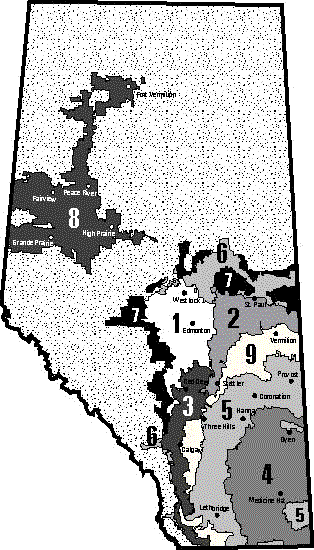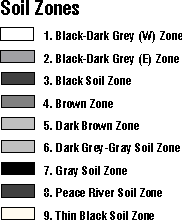| | Alberta trends | Long term consequences | Soil zone summaries of Canola Rotations in Alberta | Soil zone map
Prairie acres seeded to canola continue to expand in response to higher net returns than other field crops. This expansion in canola acres is being achieved by shortening rotations (break years between canola crops), and reductions in feed grains, forage acres and summerfallow. Observations from industry agronomists indicate that very short canola rotations (canola every second year and canola on canola) are becoming prominent in the traditional canola growing regions of Alberta. There is a lack of good statistics on canola rotation frequency in Alberta, and the associated yield performance.
Recent research experiments on the performance of short canola rotations in Alberta are sparse, and the limited data indicates that continuous canola is lower yielding than other rotation breaks. However, a wealth of information exists in the crop insurance records collected by Agriculture Financial Services Corporation (AFSC). This crop insurance database was used to summarize recent information on the frequency and yield effects of various canola rotation breaks, and canola after different crops in Alberta.
Two different datasets were extracted from the AFSC database. One dataset contained about 48,000 records from 2001-09 for the yield of canola in relation to years from last canola crop (“break interval”). Another dataset held 20,000 records from 2004-09 for the yield of canola following various crops (wheat, barley, peas, canola and fallow). Each dataset was filtered to remove records from producers that reported the same yield on all their canola fields. Data was summarized by major soil zones which represent well the areas in Alberta with different soil, climate and canola cropping practices. Average yield is not shown for situations with less than 10 data points for confidentiality and reduced reliability due to the limited numbers.
Alberta trends
Data from the productive black and grey/black soil zones in central Alberta show the trend of shortening canola rotations, and canola every second year is the most popular break interval. In contrast, long rotation intervals such as the recommended 3 year break are declining – in fact, now there is more canola on canola than the long rotations except in the Dark Brown soil zone. Although the yield comparisons fluctuate from year to year, canola on canola is consistently the lowest yielding. Canola with one or two year breaks had similar yield, and the recommended 3 year break is often best overall. On average over the 6 years in the major canola growing zones, canola on canola yielded 16% less than canola with 1 or 2 year breaks while canola with 3 year breaks yielded 5% higher than 1 or 2 year breaks.
 | Canola Yield Relative to Rotation Breaks of 1 and 2 years |
| Alberta soil zone | Canola on canola | 1 and 2 year break | 3 year break |
| Dark Brown | - | 100% | 107 |
| Thin Black | 89 | 100 | 110 |
| Black | 79* | 100 | 105 |
| Black Dark Grey East | 83 | 100 | 108 |
| Black Dark Grey West | 86 | 100 | 97* |
| Peace region | 82 | 100 | - |
*Limited data, only 3 of 6 years
Long term consequences?
Adverse long term impacts of short rotation canola are possible, and thus producers should also incorporate a risk premium when calculating the true cost / benefit of short rotation canola. One significant concern is that disease populations will shift due to high selection pressure in short rotations, leading to breakdown of canola variety resistance – this is especially worrying for diseases like blackleg and clubroot. There is some evidence from short rotation studies that blackleg incidence or severity can increase.
There are often comments from producers that short term canola has not suffered pest disasters and thus this risk may be overemphasized. However, I suggest that the increase in striped flea beetle populations especially in the Peace River region may be an example of a pest problem exacerbated by short rotation. And the rapid spread of clubroot in the Edmonton area where canola rotations are short is probably not a coincidence either! So there likely is a tradeoff – short term financial gain for possible long term pest pain!
Soil Zone Summaries of Canola Rotations in Alberta
| Break Intervals | Effect of previous crop |

 |
| Black Soil Zone
| Black Soil Zone
|
| Black Dark Gray East
| Black Dark Gray East
|
| Black Dark Gray West
| Black Dark Gray West
|
| Dark Brown
| Dark Brown
|
| Peace
| Peace
|
| Thin Black
| Thin Black
|
|
|